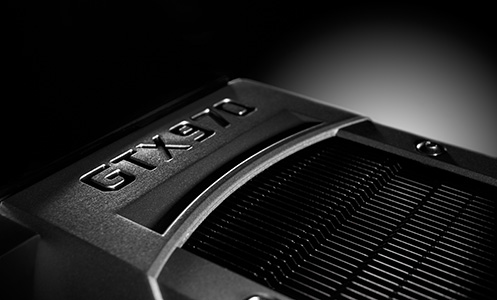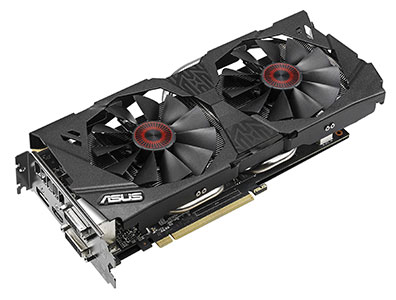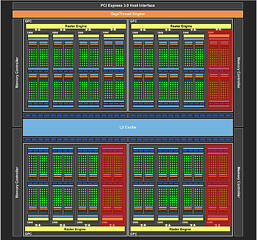 64
64
ASUS Strix GTX 970 OC 4 GB Review
(64 Comments) »Introduction

The GeForce GTX 970 is the other big graphics card launch of the day, apart from the high-end GeForce GTX 980. If you haven't given our GTX 980 launch review a quick browse through, check it out first as it goes into many more technical details and discusses NVIDIA's new software features. The GTX 970, much like its predecessors, the GTX 770 and GTX 670, is destined to be an underrated card decking out lower shelves under the GTX 980's shadow. Steam Hardware survey trends would also agree with our guess that this card will end up selling more between the two in volume, probably even fetching NVIDIA more revenue.

Priced at $329, displacing the GeForce GTX 770 (which is now discontinued), the GTX 970 is a higher-grade performance-segment graphics card not too far away from the crucial $250 price-point, which earns NVIDIA and AMD a sizable bulk of their discrete GPU revenues. The card is designed to run anything you throw at it at resolutions as high as 2560x1600 pixels and, perhaps, even Ultra HD, with watered down details. That alone makes the GTX 970 very exciting because today's $250 offerings, the Radeon R9 285 from AMD and NVIDIA's own GTX 760 (it saw a price-cut down to $220 at the time of writing), will run anything at 1080p, but may falter with higher resolutions. So your choice boils down to whether spending an additional $80 as a feature-proofing measure is worth it to you.
The GeForce GTX 970 is carved out of the 28 nm GM204 silicon on which the GTX 980 is based, by disabling three of sixteen streaming multiprocessors with, each, 128 CUDA cores. The resulting shader count is 1,664. Texture memory units are, proportionately, down to 104, as are clock speeds, although they stay well above the 1 GHz mark. The ROP count stays at a whopping 64, with a 256-bit memory bus width and a standard memory total of 4 GB.

Today, we're reviewing the ASUS STRIX GeForce GTX 970 OC, a non-reference design, factory-overclocked GTX 970 graphics card with a custom-designed PCB and the company's new STRIX cooling solution, which stops the fans in idle for a completely noiseless experience. According to ASUS, the card will retail for $349.
| GeForce GTX 680 | GeForce GTX 780 | Radeon R9 290 | GeForce GTX 970 | ASUS GTX 970 STRIX | Radeon R9 290X | Radeon HD 7990 | GeForce GTX Titan | GeForce GTX 780 Ti | GeForce GTX 980 | |
|---|---|---|---|---|---|---|---|---|---|---|
| Shader Units | 1536 | 2304 | 2560 | 1664 | 1664 | 2816 | 2x 2048 | 2688 | 2880 | 2048 |
| ROPs | 32 | 48 | 64 | 64 | 64 | 64 | 2x 32 | 48 | 48 | 64 |
| Graphics Processor | GK104 | GK110 | Hawaii | GM204 | GM204 | Hawaii | 2x Tahiti | GK110 | GK110 | GM204 |
| Transistors | 3500M | 7100M | 6200M | 5200M | 5200M | 6200M | 2x 4310M | 7100M | 7100M | 5200M |
| Memory Size | 2048 MB | 3072 MB | 4096 MB | 4096 MB | 4096 MB | 4096 MB | 2x 3072 MB | 6144 MB | 3072 MB | 4096 MB |
| Memory Bus Width | 256 bit | 384 bit | 512 bit | 256 bit | 256 bit | 512 bit | 2x 384 bit | 384 bit | 384 bit | 256 bit |
| Core Clock | 1006 MHz+ | 863 MHz+ | 947 MHz | 1051 MHz+ | 1114 MHz+ | 1000 MHz | 1000 MHz | 837 MHz+ | 876 MHz+ | 1126 MHz+ |
| Memory Clock | 1502 MHz | 1502 MHz | 1250 MHz | 1750 MHz | 1750 MHz | 1250 MHz | 1500 MHz | 1502 MHz | 1750 MHz | 1750 MHz |
| Price | $340 | $420 | $370 | $330 | $350 | $460 | $1000 | $1000 | $590 | $550 |
Packaging
The Card
ASUS is using the same heatsink as on the ASUS STRIX GTX 780. It features two fans which stop in idle and only spin up once the card exceeds 67°C. A backplate has also been applied to protect the card from damage during handling. Dimensions of the card are 28.0 cm x 14.5 cm.
Installation requires two slots in your system.
Display connectivity options include two DVI ports, one HDMI port, and one DisplayPort. You may use all outputs at the same time, so triple-monitor-surround gaming is possible with one card.
The GPU also includes an HDMI sound device. It is HDMI 2.0 compatible, which includes HD audio and Blu-ray 3D movies support.
You may combine up to three GTX 970 cards in a multi-GPU SLI configuration. AMD recently switched to transferring CrossFire data via the PCI-Express bus, in order to handle 4K frames. NVIDIA's SLI suffers from no such limitations, so there is no reason to use PCIe.
Pictured above are the front and back, showing the disassembled board. High-res versions are also available (front, back).
A Closer Look
ASUS uses three heatpipes in their STRIX cooler to keep the GPU cool.
A little heatsink provides cooling for the VRM circuitry.
The backplate ASUS used bends around the back for some extra stability.
Power delivery requires a single 8-pin PCI-Express power connector. This configuration is specified for up to 225 W power draw.
ASUS rebranded their voltage controller. It supports software monitoring and voltage control.
The GDDR5 memory chips are made by Samsung and carry the model number K4G41325FC-HC28. They are specified to run at 1750 MHz (7000 MHz GDDR5 effective).
NVIDIA's new GM204 graphics processor brings the Maxwell architecture to the high-end. It is produced on a 28 nm process at TSMC, Taiwan, with a transistor count of 5.2 billion and a die size of 398 mm².
Our Patreon Silver Supporters can read articles in single-page format.
May 3rd, 2024 13:44 EDT
change timezone
Latest GPU Drivers
New Forum Posts
- Announcement: VPN's no longer work right in Windows 10 or 11 or Servers (13)
- 7900 XTX Seriously lacking (111)
- My Laptop is having issues with PL2 and EDP OTHER (5)
- TPU's Rosetta Milestones and Daily Pie Thread (1869)
- Have you got pie today? (16325)
- SMART Access Memory disabled in 24.4.1 driver (6)
- WCG Daily Numbers (12505)
- Microsoft Did It Again! Beware Of Bugged Update KB5034441 (190)
- Folding Pie and Milestones!! (9016)
- Need advice for UPS that will be use only for bios updates (4)
Popular Reviews
- HYTE THICC Q60 240 mm AIO Review
- ASRock NUC BOX-155H (Intel Core Ultra 7 155H) Review
- Meze Audio LIRIC 2nd Generation Closed-Back Headphones Review
- Montech Sky Two GX Review
- Ugreen NASync DXP4800 Plus Review
- Upcoming Hardware Launches 2023 (Updated Feb 2024)
- Team Group T-Force Vulcan ECO DDR5-6000 32 GB CL38 Review
- MOONDROP x Crinacle DUSK In-Ear Monitors Review - The Last 5%
- AMD Ryzen 7 7800X3D Review - The Best Gaming CPU
- Logitech G Pro X Superlight 2 Review - Updated with 4000 Hz Tested
Controversial News Posts
- Intel Statement on Stability Issues: "Motherboard Makers to Blame" (234)
- Windows 11 Now Officially Adware as Microsoft Embeds Ads in the Start Menu (167)
- Sony PlayStation 5 Pro Specifications Confirmed, Console Arrives Before Holidays (117)
- AMD's RDNA 4 GPUs Could Stick with 18 Gbps GDDR6 Memory (114)
- AMD to Redesign Ray Tracing Hardware on RDNA 4 (111)
- NVIDIA Points Intel Raptor Lake CPU Users to Get Help from Intel Amid System Instability Issues (106)
- AMD "Strix Halo" Zen 5 Mobile Processor Pictured: Chiplet-based, Uses 256-bit LPDDR5X (103)
- AMD Ryzen 9 7900X3D Now at a Mouth-watering $329 (103)


















